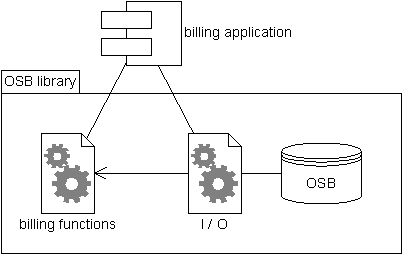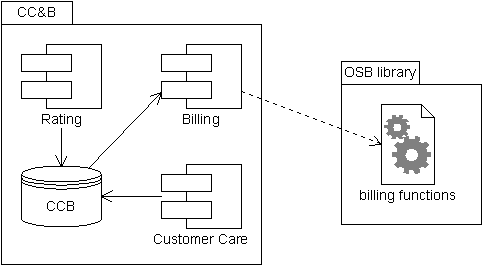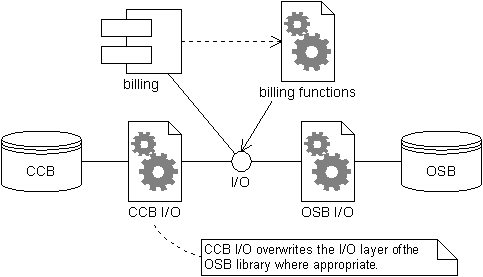
Case study: Integration with other systemsBy the example of the billing module this document describes integration strategies of OSB with other systems. |
The billing module consists of the four components application, functionality, I/O and the OSB database objects as shown in diagram

The billing application controls the billing process. It
is, e.g., responsible to determine the contracts to be billed and
for the distribution among several billing processes. The
application is customer specific and therefore not part of the
OSB library.
The sample billing applications is of course not able to use any
customer specific OSB library extensions, it is rather supposed to
be the starting point for any customization needed.
The billing application relies on the I/O functions for read or write access to the database and uses the billing functions to create the invoices. Billing functions that need information from the database also use the I/O layer, retrieved data however should be cached in the billing application to avoid unnecessary I/O operations.
For the communication between the billing application, the billing and the I/O functions OSB objects are used. The I/O layer translates between OSB objects and the OSB database objects.
The separation of the billing functions from the I/O as
indicated in diagram I is idealized. The way I've shown it will
help us in understanding how other system can actually intergrate
the OSB billing module.
In reality object-oriented design suggests that read and write
operations should be member functions of the OSB classes. Of course
there are pure data classes and mere functional classes that rely
on them, but we will also have classes where both aspects are
mixed.
The important thing is that in all classes I/O operations are
isolated what allows to overwrite them if, e.g. a different
database server is used.
| By definition the database I/O methods of the OSB classes are implemented for the default database server. |
| The billing application should control all updates of the database. A billing function therefore should not write to the database via the I/O module. Any exception to this rule must be clearly documented. |
Diagram shows the collaboration of the OSB billing module with another system: CC&B.

Existing CC&B applications like Customer Care and Rating produce data that are stored in the database CCB. Billing collects the data generated by other modules and uses the billing functions of the OSB library to create the invoices. The database OSB is not shown in the diagram: it depends on the integration strategy whether it is needed at all.
Any integration of the OSB billing module into a
CC&B system must respect the principle that the billing
functions of the OSB library only work with OSB objects: Offering
other interfaces would mean that the core of the library must be
permanently changed, not because new functionality is added but for
integration with other systems. Such an approach of course would be
unfavorable for the stability of the library.
As a consequence of this principle the billing application has to
use OSB objects, though it might rely on other objects as well. I/O
operations that are needed by the billing functions have to support
OSB objects as well.
With the rules as described above we have three approaches how to integrate the OSB billing module:
In this approach existing applications of the target system are
changed to read and write OSB database objects if billing relevant
data are involved. In terms of OSB such data are taxation keys,
products and product items, ... .
This strategy allows unrestricted use of all available billing
functionality at the cost of the implementation effort in the
applications of the CC&B system.
It is not always possible to change applications of a CC&B system. This means that OSB billing on one hand must use the foreign data while on the other hand OSB objects are needed to access the billing functions. In order to fulfill this requirement we can extend the I/O functions of the OSB library to create OSB objects from database objects of the target system and vice-versa as shown in diagram

The replacement of the OSB I/O functions is only possible if their interface remains unchanged, however additional I/O functions may be provided in the interface of the CCB I/O library if necessary. Additional, OSB specific configuration data are needed. They may be either stored in a separate database OSB as indicated in diagram III or -if we are allowed to do so- inside the database of the CC&B system.
This method has the advantage that no extraordinary changes are needed in the billing application; but some OSB billing features may not be usable, simply because necessary are not maintained by the taget CC&B.
In this approach the data stored in the CC&B database (master) are translated and stored in the OSB database (slave). The billing application uses solely the OSB database to generate the invoices and to store the results. In a subsequent step the results are translated and made available in the CC&B database. The synchronization between the CC&B and OSB database can be obtained by several means:
The master - slave model allows the complete separation of the
billing from other applications. The main problem yet to be solved
is how we can guarantee the accuracy of the synchronization between
the databases.
It should be noted that the real time mode is quite similar to
working directly against OSB database objects, and that on-demand
more or less corresponds to the replacement of the I/O functions.
The main difference is that data are stored twice, once in CC&B
and a second time the OSB database.
Ideally, in an integrated system, there is a central customer database which is used by all systems. This customer database will have some sort of unique identifier to reference a customer. In practice, every connected system will have its own customer structure and customer identifier. In between, there is a need to translate identifiers. I.e., every satellite system will have to provide two conversion functions:
masterCustomerID = convertID ( satelliteCustomerID )
satelliteCustomerID = convertID-1 ( masterCustomerID
)
Now let's assume that two satellite systems are connected to a master system and the two satellite systems also need to interact with each other. In this case, the satellite systems will communicate using the masterCustomerID. There will not be any additional conversion functions for the direct conversion of identifiers between satellite systems.